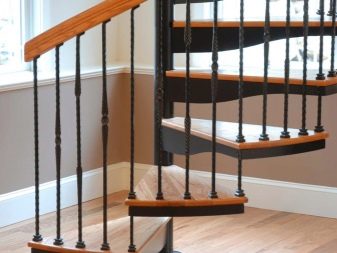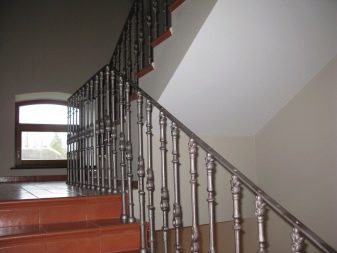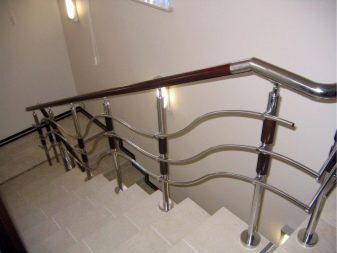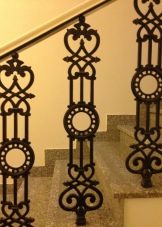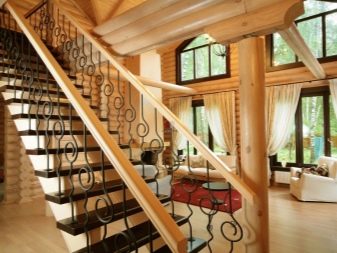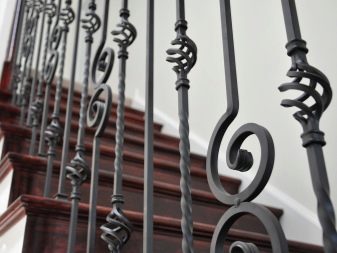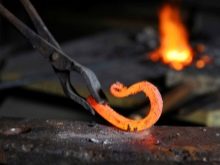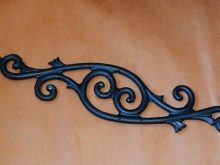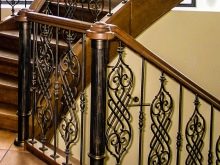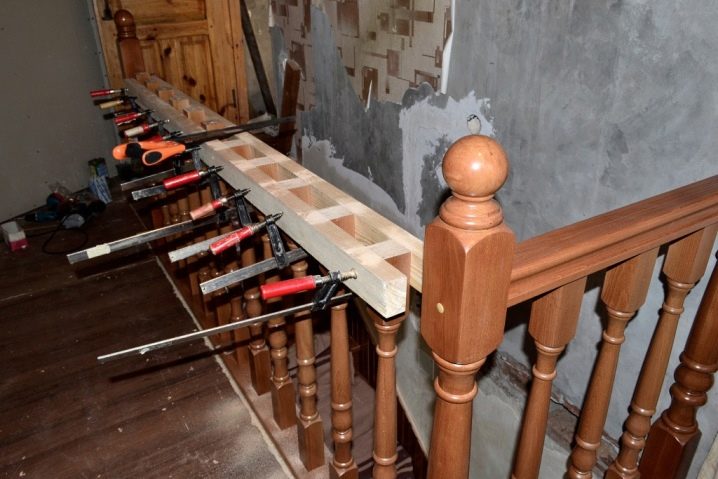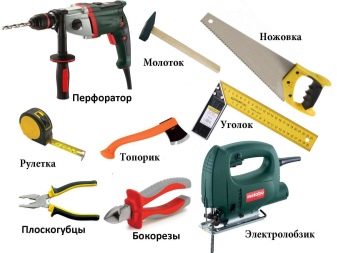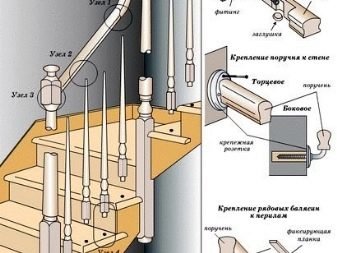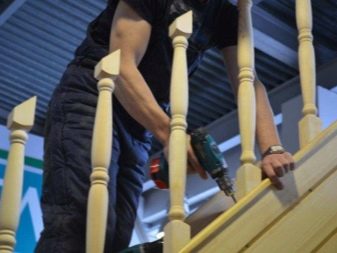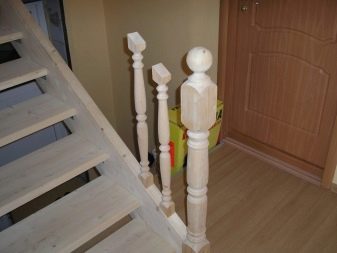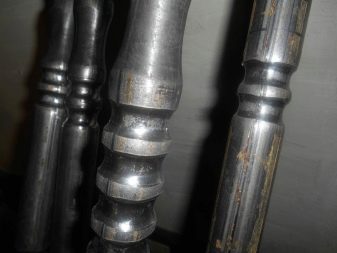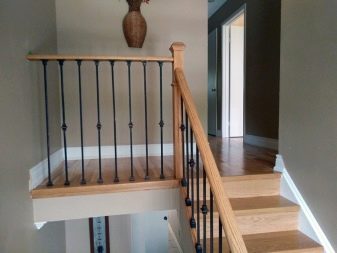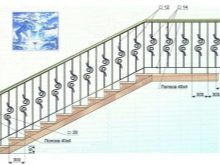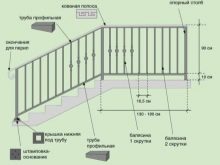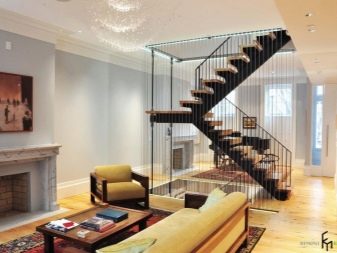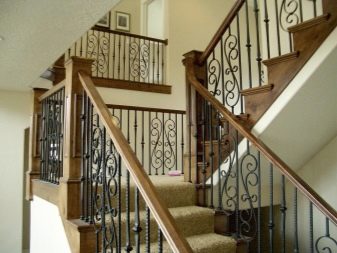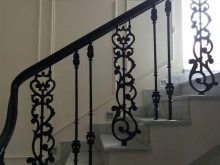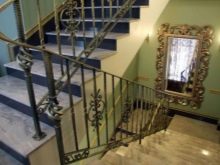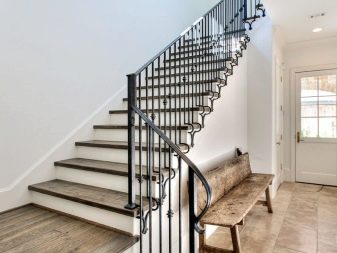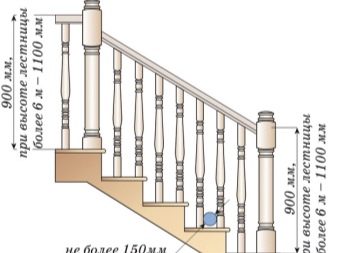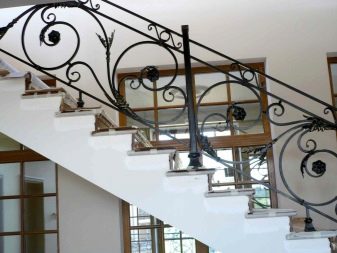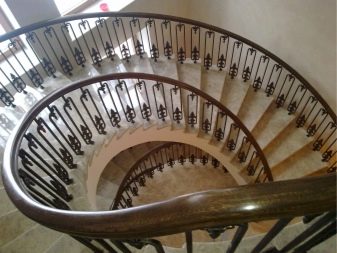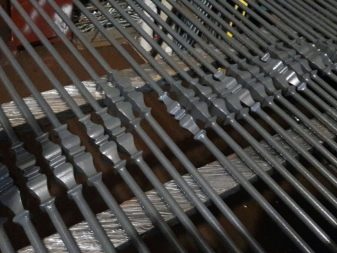Modern metal balusters: types and design
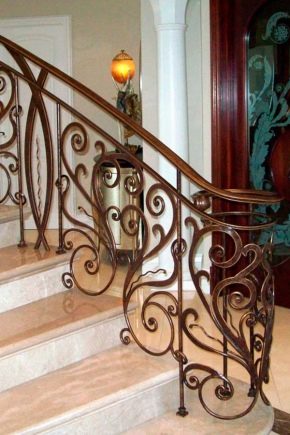
Decorative fencing for stairs is a beautiful and aesthetic solution both for the design of outdoor fencing and for interior spaces. Balusters are the traditional and best method for decorating stairs.
What?
Baluster - an element of a support of a design, for example, a ladder. Represents a column supporting a prop. Balusters must be mounted vertically in compliance with the technology during installation and with accurate measurement of the height of the support. Fastened to the stairs.
Materials
To create balusters, ductile metals resistant to cold, moisture, and corrosion are required. Various metals and alloys are most suitable for these purposes.
Stainless steel
This material is highly resistant to corrosion, so that it is often used in the creation of street fences. Elements of this material do not rust even when they are hit by reagents for melting snow. Chrome elements can withstand large temperature differences and high humidity.
Today parts are made with many types of mounting and installation. Thanks to this stainless steel balusters are in great demand.
Cast iron
The use of cast iron elements is a very old classic method for arranging fences. They do not lose their original appearance even after many decades. And they can also be given almost any shape thanks to modern technology. In addition, cast iron elements can be combined with any other materials, such as wood. They are the same as steel, because of their resistance to corrosion, can be installed outdoors.
Iron
Iron elements are made of iron itself or alloys that need to be painted or processed after installation. They are the most inexpensive and easy to install. However, they can turn out quite aesthetic fencing. Mounted to the railing either by using threaded connections or by welding. As a rule, these elements are used for external structures.
Production options
There are three ways to create metal balusters.
- Cold forging. With this method, metal rods and other parts are not exposed to heat. Material processing takes place with the help of special machines and cutting tools; processing is almost not done manually. This method is quite cheap because it is widely available.
- Hot forging. This method involves processing the metal after pre-heating to a certain temperature at which it can be forged. This processing is carried out only manually, because of this, it is quite expensive due to its exclusivity.
- Stamping.It assumes mass punching of the same balusters in a certain form with the help of special machines on the same sample.The method is extremely cheap, because it is used in those cases when it is necessary for large spaces to be equipped with the same type of balusters: streets, parks, large rooms, and so on. And also, the method is distinguished by its efficiency and wastelessness.
Stamped balusters in different ways. In total there are several types of molds for casting products:
- clay-sandy;
- chill mold;
- melted molds;
- vacuum method.
But also, in addition to metal supports, supports can be used with a combination of several different materials: mainly wood and metal. Such solutions also look great in any building or room.
Benefits
Unlike wooden fences and poles, metal have a lot of advantages.
- Fire resistance In the event of a fire, wooden poles will quickly burn out, which can cause great damage to both the room and the health of people. Metal supports are undoubtedly better.
- Strength. Over time, wooden structures become useless due to environmental factors: moisture, insects, and so on. Metal factors are not afraid.
- The possibility of giving almost any form. Wood is not easy enough to process, especially to give a complex shape: petals, various patterns, drawings, and so on.Metal is easy to give the desired shape due to its malleability, which is an added advantage.
How to replace and strengthen balusters?
Balusters and other parts of the stairs are continuously subjected to high loads, broken or damaged. Putting them in order is simple, but it is of great importance. We will understand how not to complicate the repair of damaged balusters.
Balusters are the main part of the stair railing. They guarantee safe movement, and in addition, decorative. The most popular material for the manufacture of balusters - wood. It can be birch, pine, oak, ash, larch, beech, as well as metal or combined elements.
Any material is constantly at risk of breakage and deformation.
To repair the staircase elements at the right time means to guarantee your own safety, as well as long and successful operation of the structure. Consider if you have a built-in wardrobe under the stairs in your house. Find out detailed information on the manufacture of such cabinets.
Tools and materials
To carry out repair work with balusters,You will need the following accessories:
- wood glue;
- putty;
- nails;
- pencil;
- adhesive tape;
- putty knife;
- cutter;
- chisel;
- ticks;
- drill;
- screw clamp;
- hammer.
Dismantling balusters
Before replacing the baluster, learn how to attach it to the string and handrail. The bowstring is a longitudinal inclined beam, necessary for fixing the stair steps. This is necessary for proper installation.
- If the base of the baluster is inserted into the string, then remove the screws or nails with which it was attached.
- If the baluster is planted on glue, it should be cut at the level of fastening. Then drill the remaining part of the tree and gouge the chips with a chisel.
- If the baluster has damage, you need to cut it a little above the break. Then clamp the base with tongs and loosen the mount, turning it in different directions. Baluster need to loosen and remove from the groove.
Fastening balusters can be done in various ways.
- First of all, check its verticality. Place a wooden plank under the rail between the two balusters. Then secure it in place with a screw clamp.
- Drill a hole in the crown of the baluster and expand it by milling.
- The edge of the wooden planks cover with wood glue.
- Beat the wooden bar in the gap where it should be.
- Remove excess glue with a sponge.
- Drive nails. Before this, blunt their edge.
Design features and installation of metal fencing
The dimensions of the fences can be absolutely any, as long as they look aesthetically pleasing. However, it should be noted that the recommended thickness of the baluster is from four to eight centimeters.
The type of installation of the structure depends on many factors: where it is located, what are its dimensions, and so on.
There are four types of mounting:
- anchor;
- flange;
- concreting;
- special fixation against vandals.
The latter type is often used when fixing street fences. Anchoring is used when installing small-sized structures. Concreting is used for the installation of heavy cast iron elements.
Dimensions
For comfortable use of stair railing baluster should have optimal size.
- Height balusters. To make it convenient to use the stairs, you should take care of the height of the railing, including balusters. The standard height of the baluster is eighty centimeters. At this height from the floor, the railing is comfortable to use. However, if you plan to use the railing for personal use only, you can set the height at your own discretion from about sixty to one hundred fifty centimeters.
- The distance between the balusters. The width between the columns of the fence may be different, it is calculated from its size and total. If children can be near the fence, then the width between the balusters should be from eight to ten centimeters. Such a distance ensures safety: the child will not get stuck in the structure and will not be injured. With a baluster thickness of four to eight centimeters, the optimal distance between them is from twelve to fifteen centimeters.
Interior styles
The beauty and aesthetics of metal fencing - one of the main criteria when choosing. It is necessary to take into account one or another style so that it blends into your interior, and does not spoil it.
There are a lot of fencing styles, there are several basic ones.
- Modern This style shows the high cost and luxury. It is rarely used for forging products.
- Art Deco. It is a combination of the incompatible: geometry and avant-garde, broken corners and soft outlines. This style is quite beautiful and aesthetic, perfect for fencing near the entrance. Painting of the pipe can be done by hand.
- Neoclassicism. Minimalism in its purest form, nothing superfluous. Neoclassicism is ideal for fencing a country site or home and garden.
- Baroque. Many small details, curls and luxury - these are the main features of the Baroque. Balusters in this style with a lot of petals, flowers and other things are done only manually, because few can afford it.
- Rococo. This style is perfect if you are looking for something unusual and bright. Many combs, lines, kinks and colors - the main differences of this style. Like the baroque, Rococo-style products are handmade, so it is also quite expensive.
- Gothic. This medieval style is characterized by high narrow spans, peaks and trefoils. Everything in it resembles the ancient times of knights and beautiful ladies.This style will emphasize the unusualness of your site.
- Antiquity. Classic style originally from ancient Greece. Differs in aesthetics, soft lines and elegance. The presence of geometric lines and simplicity makes it a great solution for a country site.
Safety requirements
Regulations, such as GOSTs and SNiPs, require that you follow clear rules when installing supports for stairs.
- To avoid injury and injury, the gap between the balusters should be closed. In kindergartens, nurseries and other institutions should be handrail at a height of fifty centimeters.
- The height of the fence should be more than ninety centimeters.
- During transitions and turns, the railing should be rounded, this should be done for the sake of safety and convenience. And also handrails need to be installed at a width of thirty centimeters from the edge of the steps.
- Stair railing should hold a load of at least one hundred kilograms per meter to ensure the safety of people.
- If there are children in the room, then the distance between the balusters should be no more than fifteen centimeters so that the children do not manage to stick their heads between the supports.
- In the case of installation of the fence to the wall, the width between the wall and the handrails should be from seven to ten centimeters.
- Cover plates, mounted on handrails, must be free of obvious defects: irregularities, curved joints, and so on.
Features of the installation of metal balusters
When buying a finished product, the consumer gets it disassembled with ready-made holes and fixings, brackets, hinges, balusters, support elements and other necessary components.
First of all, you need to pay attention to the upper and lower baluster, as they will be a large load. These balusters will serve as a support for the rest of the design details. Next, referring to them, find a place to install balusters, stretching the thread from the first to the last support.
In case there are no installation slots in the construction, mark the places where they should be by measuring the length of the stairs and calculating the length for their installation.
Baluster - the most important element of various fences. This item is resistant to adverse conditions, safe and durable, if made of metal. However, aesthetic qualities are also important.The product, made in a well-chosen style, will be an excellent solution for gardening, street fencing and interior of an apartment or house.
In the video below you can see how to forge balusters.

